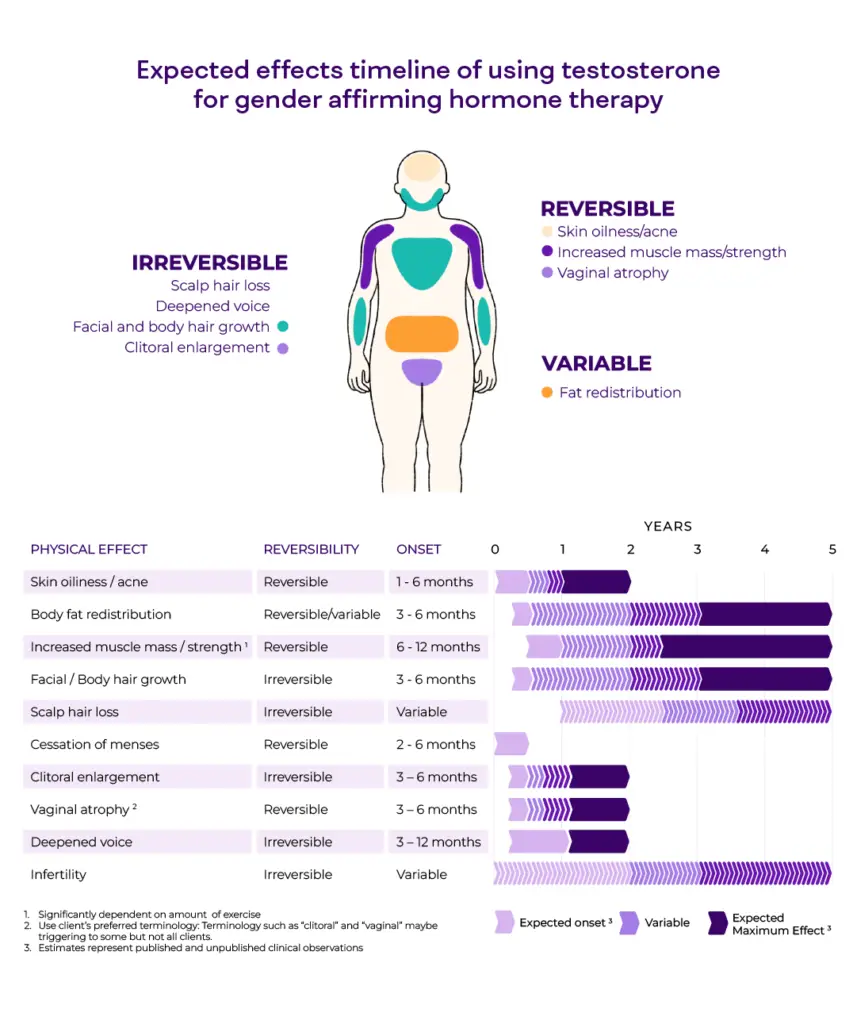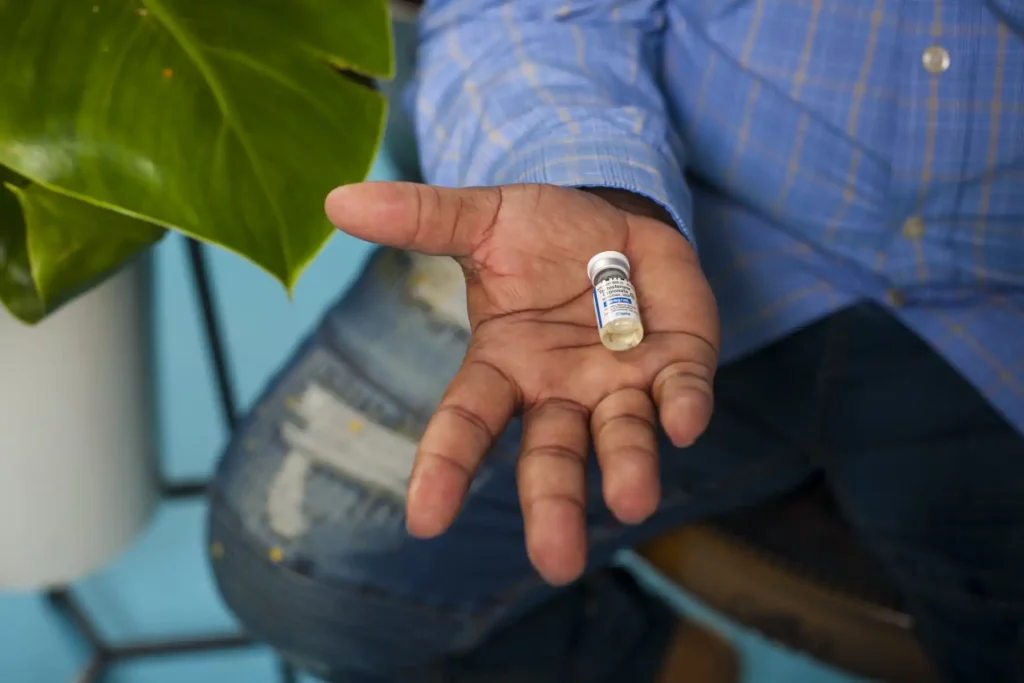
For transmasculine folks embarking on their gender journey, testosterone can represent a major catalyst for change. From the subtle shift in voice tone to the emergence of facial hair, the effects of testosterone can feel like the bridge between self-perception and outward presentation. At Plume, we are excited to guide you through this transformative process by providing clarity, support, and gender care expertise to those navigating the complexities of gender-affirming hormone therapy. Learn everything you need to know about taking testosterone for gender-affirming therapy below.
Table of Contents
What is testosterone (aka T)?
Testosterone is a naturally occurring hormone that is typically produced in all bodies. Different bodies produce different amounts of this hormone. Plume prescribes synthetic bioidentical testosterone to encourage physical changes in your body. These changes on testosterone—both dramatic and subtle—can help you to live as your authentic self by changing your gender expression to reflect your gender identity.
What physical and psychological changes on testosterone are possible?
Most folks start to notice changes on testosterone like lower voice, facial hair growth, and stopping of monthly bleeding after 2-3 months on T. While many things contribute to our mental health, many folks notice feeling better emotionally shortly after starting T. In particular, they notice decreased anxiety and increased confidence. Physical changes on testosterone will occur more gradually and become noticeable after six months. Most folks will max out on physical changes somewhere between 2-5 years after starting T. Monthly bleeding can take 6-12 months to stop.
Not all of these changes on testosterone are irreversible, but this can vary for each individual. Typically, the changes that are most likely to be irreversible are lowered voice tones and coarse hair growth, such as beard growth. The degree of these “masculinizing” changes differs for each person’s body. Your results will vary based on your genetics. The effects of T that people most commonly experience include:
- Body fat redistribution (decreased in the buttocks/hips/thighs, increased in the belly)
- Increased muscle mass
- Increased and darker facial and body hair growth
- Redistribution of facial fat/changes in facial structure
- Increased libido (sex drive)
- Enlargement of some genital parts (ie, clitoral or “bottom” growth)
- Deepening of the voice
- Increased oily skin and acne
- Increased dryness or discomfort in the genital area
- Hair loss at the front and top of the head (this change is more dependent on a family history of baldness and typically is more of a concern after a year on T)
- Change in menstrual periods (typically stopping within 1-6 months of testosterone, depending on dose)
- Mood changes
Some changes on testosterone can be less desirable. Fortunately, we have treatments to help make these issues more comfortable:
- Increased oily skin and acne
- Increased dryness or discomfort in the genital area
- Recession of the hairline, although hair loss is more dependent on a family history of pattern baldness and typically is more of a concern after one year on T
How can I take testosterone?
Testosterone comes in several forms – including a weekly injectable or daily topical (cream or gel). Each method effectively raises your T levels, leading to the physical changes discussed above. Choosing a method usually comes down to deciding what feels most comfortable and what fits into your budget. Injectable testosterone tablets are available but typically run hundreds of dollars each month and are rarely covered by insurance at this time.
Injection
Injection is the most common way of taking testosterone. It is a popular choice because it is relatively affordable and doesn’t require daily application (compared to topicals). Injecting can also make it very easy to adjust your T dose in small increments. Because of this, injection is a good option for “microdosing.” (You can read more about microdosing below). There are two methods of injection. They both use the same dose of T. Both are administered once a week and work the same way.
Intramuscular (IM) injection – An injection into the butt, glute, or thigh area. Alternate your injections between those areas and change the sides of your body for each injection.
Subcutaneous (SC/subq) injection – Uses a shorter, thinner needle. This type of injection is given just under the skin into the belly or upper thigh fat.
If you want, you can always change injection styles. Just let your provider know if you want to switch. Your prescription includes syringes and needles, so you have everything you need. You will get a larger, wider needle to draw up the T with your prescription because it is in a thick oil. The larger needle lets you draw the liquid out of the vial quickly. You will also get a thinner needle that you will inject with. You draw up with the thick needle, switch to the thinner one, and do your shot. We recommend and prescribe the 1-ml syringe because it is easier to see all the markings, especially if injecting less than 0.5 ml.
We know some folks can be anxious about injections. If you feel nervous, that is completely normal! We will provide you with teaching videos and walk you through how to inject if you choose to do injections. Our goal is for you to feel as prepared and relaxed as possible for your first injection, but most people will tell you that it can take weeks to feel comfortable. So slow down, take a deep breath, and do your best! In the end, we have other forms of T that are just as effective. So if it’s simply too overwhelming and you want to switch methods, let us know, and your provider will gladly send a new prescription to the pharmacy of your choice.
Topical gel
Topical gel is a great, effective alternative to injections. Many people choose a topical if they prefer to avoid injections. You apply it every morning after your shower on clean, dry skin (usually to the shoulders or upper arms, but you can talk to your provider about other areas that might work for you). After applying, you should wash your hands and make sure the gel is completely dry before putting a shirt on. Depending on your gel, it’s best to wait anywhere from 2-6 hours before showering or swimming. The gel can rub off onto other people with skin-to-skin contact or from clothing to another person, and this can cause unwanted masculine physical changes in that person – so caution is advised.
Patches
Testosterone patches used to be a way for patients to dose testosterone. However, in early 2023, T patches stopped being manufactured entirely. We will update you if these become available in the future.
What is “microdosing”?
Microdosing is a newer term that describes using a small amount of a medication to achieve subtler or different effects from more common dosing recommendations. For example, some nonbinary people do not want to look like “men” but want more masculine features such as more defined facial features or a lower voice. A microdose of T will achieve these changes over a longer period, and the changes will be less dramatic than the ones someone might notice on the full dose of T. Microdosing is a very individualized process. We cannot pinpoint specific physical traits or rates of change. However, we can support you while you find the correct dose.
You can choose a lower dose option if you want a more subtle physical change. If you’re going to take the quickest route to maximizing physical change, then your Plume provider can help you start at a higher dose. Let your care team know what feels right for you, and we will help you reach your transition goals!
What are the possible risks of testosterone?
When used appropriately under the supervision of a medical provider, testosterone is safe. Of course, every medication has risks, and it is important to understand these to make an informed decision about your care. We will discuss some of the risks here, but review the informed consent form (sent through our app before your medical visit) and discuss any questions about your medications with your medical provider.
Testosterone and birth defects
T increases the hemoglobin/hematocrit (“H/H”). Think of H/H as the amount of red blood cells in your body. For example, anemia is diagnosed as low H/H because people with anemia have fewer red blood cells. But, if someone’s H/H were to go too high, there is a theoretical risk of blood clots and stroke because of the blood being too “thick.” We have not yet seen documented cases of this happening with gender-affirming care. However, to ensure that your H/H stays in a healthy range, we will check your red blood cell count every three months, along with your T levels.
Some medications, like T, are dangerous during pregnancy. Like alcohol and cigarettes, T is a teratogen, which is a substance that is known to cause severe birth defects. So, if anybody who is taking T were to become pregnant, there would be a high risk of birth defects in the fetus. If pregnancy is a possibility at all (based on your body parts, those of your partner(s), and your sexual preferences), we strongly encourage contraception to prevent pregnancy while taking T. All forms of birth control are safe to use if you are on T and do not interfere with the effects of T on your body.
Testosterone could cause infertility
Over time, T causes levels of estrogen to drop. This, in turn, causes changes to other body parts, such as the ovaries and uterus. These organs are essential for carrying a pregnancy to term. It is impossible to predict who will be affected by infertility; besides, many factors can contribute to infertility that are not related to T. We recognize that there are many ways to build your family and that using your genetic material is only one of them. However, if preserving your fertility is important to you, or if you would like to have children who share your genes, then we strongly encourage you to see a reproductive specialist regarding the freezing of your eggs.
If somebody on testosterone wants to become pregnant or use their genetic material, they have to stop taking T for 6-9 months beforehand. When T levels have lowered, it’s possible to become pregnant and carry to term or store genetic material for future use. Whatever your hopes are for starting a family, know you have options. The most important thing is to be aware of the impact T can have on your fertility before starting the medication. We understand you might not yet have a clear answer for yourself and your future family. Still, as a side effect of your medication, there might be a possibility of becoming infertile later.
At Plume, we’re dedicated to empowering you with the knowledge and support needed to make informed decisions about your care. As you navigate the complexities of testosterone therapy, remember to honor your choices and celebrate your growth. Embrace each step forward with pride, knowing that you’re supported and valued. Trust in your decisions, lean on your support system, and embrace the changes with confidence. Your journey towards authenticity is worth celebrating, and we’re honored to be a part of it.
*Credit: GAHT effects timeline made by a queer medical illustrator, Katja Tetzlaff, with information sourced by Rainbow Health Ontario



